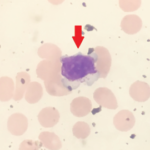Use structured interviews, and collaborate with social workers and mental health professionals to screen for abuse or psychiatric problems that cause pain in children. Targeted MRI has replaced bone scans in identifying potential malignancies that may cause walking problems in children, followed by biopsies to confirm the diagnosis.
Weakness
Proximal muscle weakness may be a sign of inflammatory muscle disease. However, it is worth asking adolescents if they lift weights, because this can elevate creatine phosphokinase levels, Dr. Miller said.
“Laboratory and muscle biopsies will exclude muscular dystrophy,” he said. Creatine phosphokinase is an important test for children with weakness. Elevated levels may result from dermatomyositis or polymyositis. Marked elevation suggests muscular dystrophy. Severe elevation may mean rhabdomyolysis. “If [creatine phosphokinase] is normal, consider chronic inflammatory muscle disease or other non-inflammatory causes.”
Pain Management
Management of arthralgias includes treating the disease, as well as non-medical approaches, such as physical or occupational therapy, guided imagery and mindfulness meditation, said Dr. Miller. Children with depression or joint pain caused by abuse should be referred to a psychiatrist or psychologist.
Physical medicine specialists may also help with pediatric pain management. Avoid pain medications and corticosteroids in children, if possible, and use non-steroidal anti-inflammatory drugs (NSAIDs) cautiously. Dr. Miller suggested alternating two weeks on NSAIDs with two weeks off, particularly if children want to get back to school during a monitoring phase.
How should rheumatologists communicate with parents about their child’s arthralgias, especially when diagnosis takes time?
“I do tell [parents] that I can’t make a diagnosis at this time based on the lab results and examination. I don’t say, ‘There is nothing wrong with your child,’” Dr. Miller said. “However, I do let the parents know that the child should return to school. I tell parents that we need to monitor their child for physical changes, and psychological examinations may be needed, as well. I don’t say goodbye, or ‘I don’t need to see your child again.’”
The evaluation of a child with arthralgias but a normal physical examination provides a challenge to rheumatologists. The possible causes of these diagnoses range from psychiatric problems to rheumatic diseases to malignancies, and the opportunity to provide the right care to these patients is highly rewarding, Dr. Miller said.
Susan Bernstein is a freelance medical journalist based in Atlanta.
References
- Petty RE, Southwood TR, Baum J, et al. Revision of the proposed classification criteria for juvenile idiopathic arthritis: Durban, 1997. J Rheumatol. 1998 Nov;25(10):1991–1994.
- Giannini EH, Brewer EJ. Poor correlation between the erythrocyte sedimentation rate and clinical activity in juvenile rheumatoid arthritis. Clin Rheumatol. 1987 Jun;6(2):197–201.



